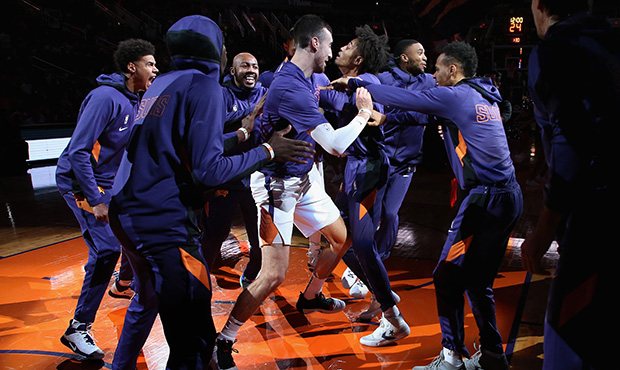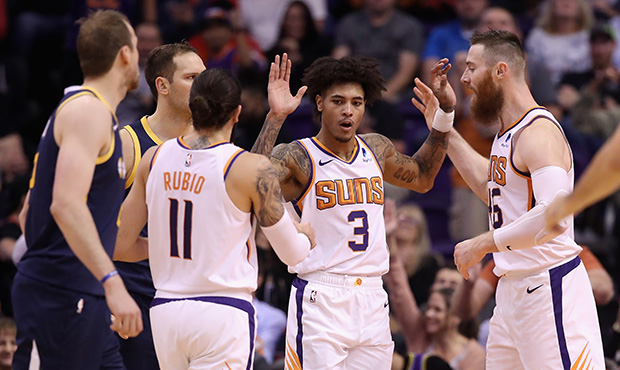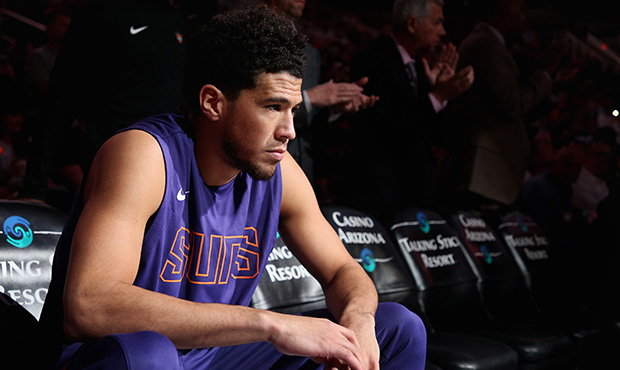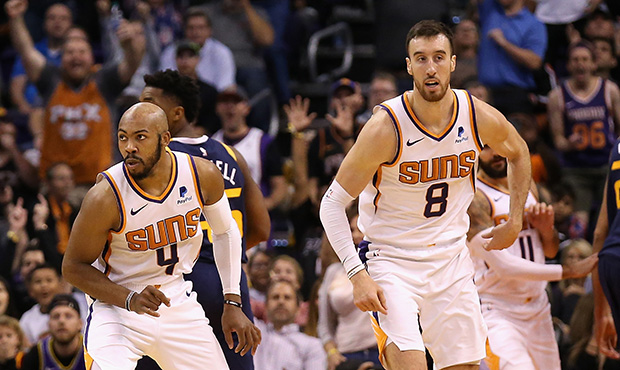
PHOENIX, ARIZONA - OCTOBER 28: (L-R) Cameron Johnson #23, Jevon Carter #4, Frank Kaminsky #8, Kelly Oubre Jr. #3, Mikal Bridges #25 and Elie Okobo #2 of the Phoenix Suns are introduced before the NBA game against the Utah Jazz at Talking Stick Resort Arena on October 28, 2019 in Phoenix, Arizona. The Jazz defeated the Suns 96-95.(Photo by Christian Petersen/Getty Images)
When Monty Williams was asked in the preseason when he would really know what he had in this Phoenix Suns team, he said it would be whenever they got punched in the mouth.
Five games in and that just hasn’t happened yet.
The Suns are 3-2, the biggest surprise in a very young NBA season, and those two losses were by a point apiece to two great teams — the Denver Nuggets and the Utah Jazz. In their three wins, they dismantled the Sacramento Kings and Golden State Warriors while controlling most of a home win against the Los Angeles Clippers.
With the combination of such a short sample size and a rapid transformation, it’s difficult to assess what exactly we have here. And we haven’t got to the points where Williams will know, either.
Let’s try and figure that out, starting with what appears to be legit.
Defensive structure and intensity
The Suns could be going through what they did at times last year, a spurt of great defense that will eventually flatten out or die altogether after a week or two.
But what we’ve seen in terms of principles and structure suggest this defense is here to stay.
Maybe not to this extent, as the Suns are fourth in points allowed per 100 possessions (98.4), first in effective field goal percentage allowed (46.1%) and fourth in points off turnovers (21.4). That’s a strong, strong level of execution, and while it won’t hold at this level, the Suns will still be competent in those areas. They are simply too active not to be.
Check out how easy of a steal this is against the Warriors. Both Dario Saric and Aron Baynes track the roll of the ball screen inside while Rubio gets by a lazy screen, and Saric is there to cut off Russell’s angle to the corner as well.
Similar play here. Both Saric and Kelly Oubre Jr. are there to suffocate the roll after Stephen Curry is taken out of the play by Rubio and Baynes.
To the execution point, notice how quickly Devin Booker, Saric and Oubre fill lanes in transition to give Rubio options. That’s a free bucket for Oubre because Booker sprinted out to get on the left wing first, dragging Draymond Green with him.
Against Utah, Rubio in this example tags the free throw line as Baynes cuts off Donovan Mitchell’s drive. Mikal Bridges works to get back when Rubio has to leave, and in case Ed Davis gets a lane, Tyler Johnson is there at the rim.
Whether it’s a turnover or not, everyone seems to be on the same page and fills out the basic responsibilities of team defense. That goes a long, long way.
Phoenix opposition averages 20.2 assists per game, the sixth-lowest across the league. That’s because of the team’s work in the halfcourt in the first half of the shot clock.
The Suns give up 98.4 points per possessions in the halfcourt, the fourth-best mark. For the context on how low that is, Phoenix averaged 115.2 points per 100 possessions allowed in the halfcourt last year. Yeah, a pretty stark difference.
They are also chasing teams off the line. The Suns allow 29.2 three-pointers, the fifth-least in the NBA.
Furthermore, all the hustle is backed up statistically. They are 13th in deflections per game (15.6), fourth in points allowed off putbacks (11.7) and tied for fifth in loose balls recovered (9.0).
It’s sustainable, whether it’s a top 20 defense in the league after a bit of a dropoff or top-five like it currently is. That might sound like a drastic dip but a “passable” defense would make so much of a difference.
Ball movement
The Suns have a lot of players who aren’t necessarily playmakers and “plus passers” but they all want to move the ball and play within the “point-five” quick decision-making system.
They are first in the percentage of their baskets assisted (70.9%) and tied for sixth in assist-to-turnover ratio (1.78).
A good example late in the shot clock below.
Jevon Carter takes a second to potentially shoot, goes down low to Frank Kaminsky, who takes two dribbles and draws the defense over. Bridges could shoot but makes the extra pass to the best shooter in the building, Cam Johnson.
Carter and Kaminsky could have isolated or Bridges could have shot. Instead, the ball moves and it finds the best possible scenario.
This is replicable.
Don’t believe me? Here we are only a few minutes later into that game.
When it doesn’t flow as naturally, dudes are moving.
The Suns average six field goals per game off cuts, tied for second leaguewide.
On this play, Bridges goes from flashing the right wing, to the corner, to seeing an opening to the baseline and taking it.
Bridges is 30 feet from the basket here. A run inside and dime from Tyler Johnson later and he’s got another bucket.
The ever-wise Eddie Johnson says “beautiful play” before Bridges even touches the ball. The winning plays are so easy to spot and the Suns are making them.
Oubre could stand in the corner after he has finished his role in this action. He doesn’t.
Again, who knows if this stays at an elite level like it is at the moment. Probably not. There’s at least concepts and a style of play to build off here, though, and one that’s going to get them a handful of free buckets each night.
Who knows if the above leads to 30ish wins, a decent feat without Deandre Ayton for 25 games, or somewhere closer to 40.
Rightfully so, the story for the Suns should be the positive team traits on both ends rather than what’s a little wonkier.
Here’s what 15 more games or so will give us a far better idea about, both good and bad.
The bad man settling in
Booker has been mediocre to his standards offensively, and this is where we should mention he’s playing the best defense of his career, by far.
He’s shooting 47.4% from the field on 24.4 points, 4.0 rebounds and 6.0 assists per game. Somehow, it feels like those should go up.
The most obvious place is the touch on his jumper in the mid-range area. On the 5.8 pull-up jumpers from inside the three-point line he’s taking a game this year, Booker is shooting 31.1%. Last year that number was 46.9%.
He’s making up for this by shooting a ridiculous 64.7% from inside 10 feet. He was at 58.8% for 2018-19, and that was a high-level output.
They just aren’t falling yet.
We’ve all watched Booker enough by now to know where he thrives more than others as perimeter scorers. It’s around the free-throw circle.
Discovering the rhythm between taking these shots and whizzing the ball around is what he’s currently plodding through.
Too many times we’ve seen him turn down a decent look to pass.
He needs to pull this or attack off the dribble in a Denver game he was desperate to get back in the flow of.
Booker will get there. Williams has done a great job tweaking the offense in the past two games to get him better halfcourt looks after a concerning start to the year.
The Suns often go as he goes, and that’s still the case offensively despite some in-game stretches where the team did well while Booker rested.
Phoenix’s offensive rating drops from 113.6 to 91.8 when Booker sits. Last year, it was around a 10-point drop, and expect that to still be the case with this group even with the depth.
Keep an eye on the runs when he’s off the court the next couple of games. Unfortunately, they’re coming.
Booker has another two levels to increase his game from last year. The defense is already one of ’em. The offense will bring another, and this current tick isn’t it. Be optimistic about a streaking November from him.
How deep is this team really?
A lot more cut and dry here.
Baynes, Carter, Kaminsky and Oubre are playing the best basketball of their lives. With that, they go a few levels higher in how they are perceived as contributors.
Baynes is a starting-caliber center at the moment. Carter is a top-tier backup point guard. Kaminsky is a Sixth Man of the Year candidate. Oubre looks like he can be the third cog behind the two pillars.
Booker, the Johnsons, Rubio and Saric have been varying degrees of what they are supposed to bring, with the rookie Cam specifically looking rotation ready like suspected after training camp and the preseason.
That’s a full, legitimate starting five and four trustworthy bench pieces. Nine deep, without even getting to Bridges, who has been the most concerning through five games, and the suspended Ayton.
Even better, all nine can shoot from deep and are doing so better than expected. Only Rubio and Kaminsky are shooting below the league average of around 35%. Cam Johnson and Booker are really the only two guys you’d expect to possibly float above that range and Baynes and Carter join them north of 40%.
Yes, all this means the Suns are a playoff team if this continues. It very, very likely will not. It’s a wait-and-see on where the consistency develops and where it does not.
Quality of play from the opposition
There’s an undeniable pushback to arrive at when projecting the Suns high enough on a potential win total.
All five teams they’ve faced have, quite simply, not played well against them. To start out of the gate here, a lot of that has to do with the way the Suns are 1) competing and 2) catching teams off-guard by doing so. They straight up mauled the Warriors. Golden State was not ready, even after four games of evidence to suggest they need to be.
The film and numbers will start to percolate with what works and what doesn’t against the Suns, something teams didn’t even have to consider in years past.
Go back above and watch all three of those defensive clips again. You’ll notice in all three that there’s at least one shooter open, albeit two of those on purpose probably to leave Green. It’s an aggressive brand of defense that leaves them susceptible.
The Suns are contesting 54.6 shots a game, tied for 28th in the NBA.
And on the 12.4 three-pointers per game Suns opponents take with as least six feet of space, meaning they are wide open, teams are shooting 29.0%, the third-lowest percentage in the league.
That’s where regression will kick in, and now teams are ready for a scrappy, intelligent opponent instead of a layup. Who can say how much variance that adds in the next month or so of basketball?
All stats via nba.com/stats and Cleaning the Glass
Sports - Latest - Google News
October 31, 2019 at 04:59PM
https://ift.tt/2JEVN2j
Figuring out the unrecognizable Phoenix Suns through 5 games - Arizona Sports
Sports - Latest - Google News
https://ift.tt/2Mbsnt7
Shoes Man Tutorial
Pos News Update
Meme Update
Korean Entertainment News
Japan News Update



No comments:
Post a Comment